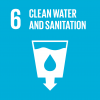Today, society is facing a multitude of resource scarcities. While rare-Earth minerals and fossil fuel depletion are some of the most-cited issues in this respect, we risk a more imminent and destructive fate: a global freshwater crisis. Our societal underestimation of this problem has amplified our precarious relationship with water and has placed many people’s livelihoods at risk. By 2025, it is predicted that two-thirds of the global population will live in water-stressed regions and that 1.8 billion people will live in areas distraught with water scarcity (UNESCO). The United Nations recognizes this issue as being of global concern and has incorporated it into its Sustainable Development Goals – Goal 6: Ensure access to water and sanitation for all – but important research is necessary to fully understand the complexities and causes of the freshwater crisis.
Environmental monitoring using space technology is rising in popularity and water is at the forefront of this revolution. From analyzing the global water cycle to studying ocean temperature fluxes, hydrologists are capitalizing on the benefits of space technology. A recent paper published in the journal Nature used satellite data to infer global freshwater availability, and it has scientists stirring worldwide. A team of researchers led by Dr. Matthew Rodell, Chief of the Hydrological Sciences Laboratory at NASA Goddard Space Flight Center, combined 14 years of GRACE satellite observations with climate data, Landsat imagery, and human activity reports to deduce global freshwater trends, identify the causes of these trends, and predict future freshwater availability. Simply put, the study found that dry regions on Earth are getting drier and wet areas are getting wetter. They concluded that unless we change our current practices, there will be substantial water shortages in many areas around the globe. Furthermore, while many trends were caused, in part, by natural interannual variability, unsustainable groundwater depletion and climate change are exacerbating this issue. This research provides “early warning to decision-makers, who have the opportunity to ensure the water is being used sustainably [and] continues to be available for future generations” says Dr. Rodell.
The GRACE satellites offer unique benefits to researchers. Satellites can reach remote locations that would otherwise not be sampled, maintain global method replication, and effortlessly cross political boundaries, therefore freeing scientists from the confines of political tensions. Space-based monitoring creates regional water management accountability and presents an incentive for change; the world is watching. Dr. Rodell stresses the importance of space technology in water research, stating that: “Installing [on the ground] automated measurement networks is expensive and labor intensive. Even in regions where they do exist, many nations either do not digitize and centralize the data or they do not make the data available to the public. Satellite observations of precipitation, soil moisture, surface water elevations, evapotranspiration, and terrestrial water storage provide global, spatially and temporally continuous measurement coverage. It would be impossible to replicate that using ground-based observations”.
Space technology has proved to be an invaluable tool for raising awareness as well as for increasing our knowledge of the water crisis. Recognition is the first step towards meaningful change and now we must alter our current practices if we want to create a water-secure future. This can be accomplished by investing in water-efficient technologies, placing an appropriate value on water as a resource, and implementing regulations on consumption. Although access to clean water is considered a basic human right, limitations to individual access will be necessary to ensure everlasting availability for all. Having more accurate predictions of water scarcity can help us prepare for these realities, implement appropriate regulations, and supply aid to the most affected regions.
Promoting freshwater security is a responsibility that also falls in the hands of consumers. As Dr. Rodell points out: “Crop irrigation accounts for upward of 80% of global freshwater consumption and, thus, the decisions we make as consumers is important”. Purchasing locally grown food, supporting rainfed/dryland farming, and/or buying food that is produced in water abundant and water sustainable regions will help reduce our demand for water resources. Other steps we can take to reduce our water footprint include installing water-efficient household appliances and faucets, reducing water pollution, eating less meat, and supporting legislation that promotes water sustainability.
If our global water usage is left unchecked, humanity will encounter a slew of consequences. The water crisis has widespread and destructive implications from environmental alteration and biodiversity impacts, to negative human health repercussions, food security complications, and social unrest. Our current relationship with water is unhealthy and requires urgent action to begin reversing the detrimental changes we have already set in motion. We have created this mess, now it is time to clean it up.
Keywords:
Freshwater availability; water management; sustainable water use; water security; water scarcity
“GRACE.” NASA. Accessed October 25, 2018. https://www.nasa.gov/mission_pages/Grace/index.html.
Rodell, M., J. S. Famiglietti, D. N. Wiese, J. T. Reager, H. K. Beaudoing, F. W. Landerer, and M-H. Lo. "Emerging trends in global freshwater availability." Nature 557 (2018): 651-659.
“Sustainable Development Goals – Goal 6: Ensure access to water and sanitation for all.” United Nations. Accessed October 25, 2018. https://www.un.org/sustainabledevelopment/water-and-sanitation/.
WWAP (United Nations World Water Assessment Programme). The United Nations World Water Development Report 4: Managing Water under Uncertainty and Risk. Paris, UNESCO. 2012.








